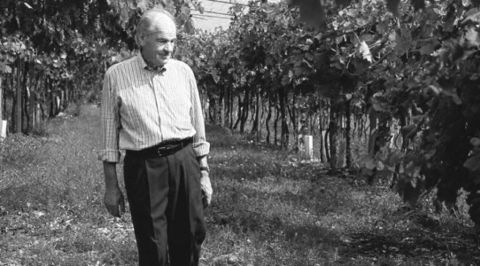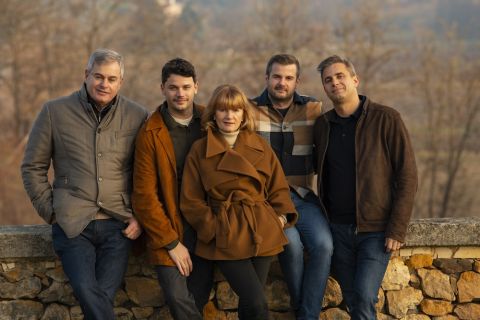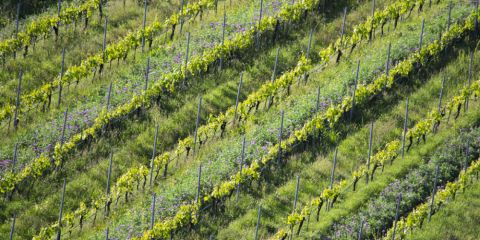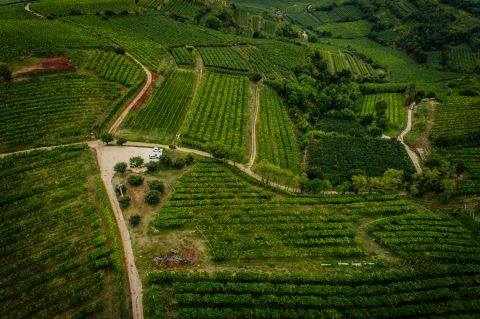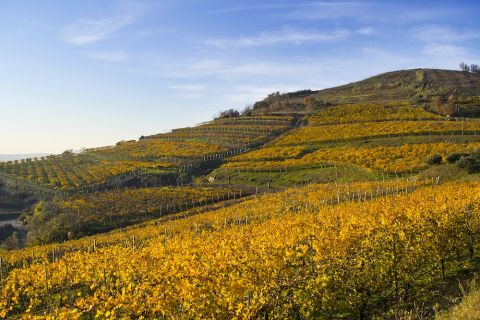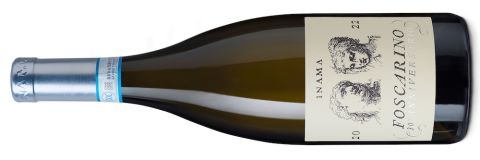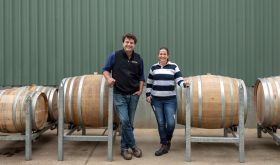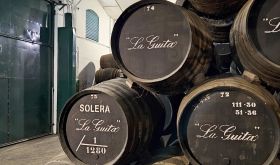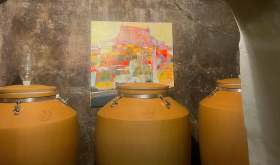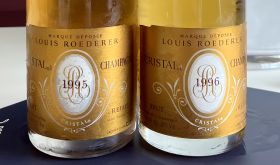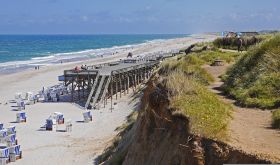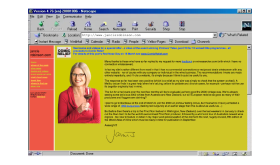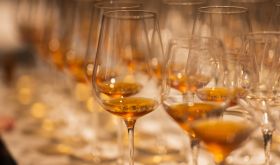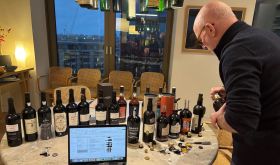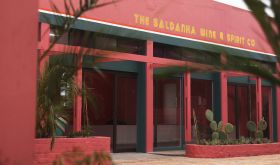In the 1940s, under the blackouts and bombs of World War II, a boy too young to fight was trying to finish high school in Trentino. He studied winemaking and viticulture textbooks by candlelight, in the bathroom, the one place in the house where he had privacy and the dim light would not breach blackout regulations. His name was Giuseppe Inama.
When the war ended, he left as soon as he could. His grandson told me that ‘he didn’t like the mentality of the mountains’, and gestured, as he said this, a narrow way of thinking. I wondered whether perhaps, also, he needed to leave a place where so many people he would have known had died, or been betrayed, or had betrayed.
Inama, part 1
He worked at a winery beside Lake Garda for one year, and then, in 1947, moved to Monteforte in Soave. A young, ambitious entrepreneur by the name of Marino Anselmi had just started a négociant business. Inama was his first employee. The two of them built up the business from nothing, first using family vineyards, then buying in grapes from local producers, then buying in grapes from across the country and selling wine across the country. Inama became head winemaker for one of the biggest bulk-wine producers in the country. But he had a secret life. At night, he came home and vinified his own wines from vineyards he was quietly buying up with his savings. From 1965 onwards, he bought land and vineyards that nobody wanted: north-facing vineyards, east-facing vineyards, properties in abandoned villages. He never wanted to be as poor, frightened, vulnerable and helpless as his family had been. He kept his head down and worked hard.
Inama, part 2
Inama’s son did not want to make bulk wine for a négociant. Stefano left home, studied for a BSc in biotech and food science and then took his young family to England for two years while he studied for a Master’s degree. He travelled the globe, tasted fine wine. In 1991, Stefano came home, wanting to make wine, but the kind of wine he’d discovered outside of Italy, not glass demijohns of wine for family consumption but ‘proper’ wine, bottled at the winery, sold with a label. It was a huge change. The family had to transition to a radically different way of working, of thinking, of being. In time, they did just that. Their first Foscarino Soave Classico was produced in 1992, followed by their first Colli Berici red in 1997.
Inama, part 3
In 2010, after four years in London working in the wine trade, Matteo Inama, third generation, joined the family company. And he, like his father, had new ideas – ideas that would take the company in a new direction. Like his father, these ideas would challenge the leadership and accepted ways of doing things in both vineyard and cellar. In Matteo’s own words, ‘At that time the vineyard management was’, and he gestures quotation marks in the air with a grin, “‘better done than perfect’”. There is a pause, then he grins more widely, adding, ‘And less done’. With international wine-industry business experience under his belt, as well as an awareness of the increasingly urgent need to address the questions of resilience and sustainability, he came home and, in his words, ‘immediately started with different processes. I began with Simonit & Sirch pruning, and this taught me about the life of the soil. We began to focus on the soil. It took a lot of years. It has been a long journey. It is still a long journey.’ He took Lorenzo Manfreda (ex Simonit & Sirch) on full-time in 2015 to work on their vineyards and then employed Stéphane Derenoncourt to focus on winemaking. They began dialling back the flashy 1990s hallmarks of oak, extraction and alcohol in favour of purity and elegance, prioritising vineyard over cellar. Recently they’ve begun working with Vitenova to obtain the Diversity Ark certification, a certification that measures, among other things, soil health using 10 parameters including microbial activity, humus and water-cycling potential; biodiversity of flora and fauna; historical context and conservation.
Even before Matteo Inama took the helm, Inama was ahead of the curve. By the time that the Soave Consorzio had decided to legally recognise the 33 ‘crus’ (officially known as UGAs, or unità geografiche aggiuntive) in 2020, Inama had been bottling a single-vineyard wine from their Foscarino vineyard for nearly 30 years. Last week, tasting Inama’s two latest releases of Foscarino (2022 and 2023), underlined just how much pedigree this vineyard and this estate carries in their DNA. We have tasting notes dating back to 2008 for the 2007 vintage, which Julia described as ‘Intensely mineral, almonds, not in the least fruity but with the very beginnings of camomile. Firm grip and lovely depth of flavour, slightly grainy texture, great length.’ In 2016, Jancis wrote about the 2014, ‘This is serious wine!’ (Note the use of one of her rare exclamation marks.)
It is 100% Garganega from old vines in the terraced Foscarino cru where the Inama family owns 23 ha (57 acres). Foscarino is a windy vineyard with terraces facing from south-east to north and on volcanic clay with rocks (some parts are more rocky than others). Because of the intensity of the wind, the grapes are smaller and thicker-skinned than normal. The Inama team (40 full-time staff) hand-pick every plot two or three times during harvest and then do a further selection on a sorting table at the winery. The grapes are macerated on the skins for eight hours and winemaking is oxidative, with full lees (Matteo Inama tells me, ‘I like to work with dirty wine, and I can do this because my grapes are clean, clean, clean’). Half of the fermentation (spontaneous) happens in used barriques; 20% in 35-hl casks and 30% in stainless steel. They stir the lees and let the wines go through natural malolactic conversion.
Don’t drink this complex, Gemini-like wine too cold. The sunny abundance is almost deceptive – you could easily get swept up in the brilliance of its brightness, in the generosity of its fruit, without realising just how layered and structured it is. You could almost miss the piano-string tension in the cavalcade of clementine, nectarine, golden currant, ripe pear, quince and apricot fruit. You need to let the cold clatter of the fridge fall back to feel the wine drift into something more luminous; to taste the vineyard herbs, flowers and stones embroidering the edges of the spaces; to feel the wine breathe deeply; to notice the quiet pause of gravitas at is centre. And then, when you do find this, you will taste the slipstream of acidity, as lustrous as phosphorescence in a still pool. And you will taste honey. And you will feel a golden glow. And you will pause, hold the beauty of it in your mouth for as long as you can. Its richness belies its mere 12.5% alcohol.
Matteo Inama suggested vitello tonnato as his favourite pairing with the wine. Short on time in the five short days between trips to South Africa and Spain, I tried it with the last of our home-grown asparagus in an omelette, and also, three days later (and still as fresh and delicious as on the day it was opened) with a fridge-raid salad of finely shaved fennel bulb, radicchio, celery, toasted walnuts, freshly squeezed lemon, lavish glugs of olive oil and snowy mountains of finely grated parmesan. It’s a wine that loves food.
There is absolutely no rush to drink this beautiful wine. It will age. So although this is officially a wine of the week for the 2022 and 2023, you will be able to enjoy well-stored older vintages, possibly even as far back as 10 years. The vineyard has class.
The 2023 is about to be shipped to the US and the UK so will be on the shelves this year. In the meantime, Waitrose stock the 2022 for £25, and it’s widely available in the US, where it is imported by DallaTerra. It’s also available in Australia, the Czech Republic, Denmark, Finland, France, Greece, Italy, Germany and Switzerland.
Explore Soave through this World Atlas of Wine map, and in many more Soave wines in our tasting notes database.
The photos above were kindly supplied by Inama, photographic credit and copyright Gio’ Martorana.


